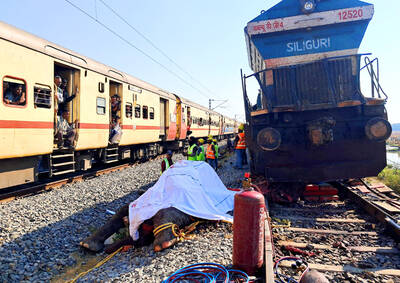Protests in a small town in China appear to have escalated with residents smashing cars and hurling bricks even though officials sought to calm tempers by suspending a plan to build a power plant.
Angry crowds smashed and overturned police cars and riot police fired teargas in Haimen town in Shantou City on Wednesday, the second day of the unrest, Hong Kong newspapers reported.
The unrest escalated as a 10-day standoff between villagers and officials over a land dispute in the same province was resolved, and as China’s domestic security chief told officials to focus on stability before the ruling Chinese Communist Party’s (CCP) leadership transition next year.
Residents of Haimen, furious with plans to build a coal-fired power plant, took to the streets on Tuesday, surrounding a government building and blocking an expressway.
Officials agreed to suspend the project this week, but residents refused to back down, demanding the plan be scrapped.
Outside a large and closed petrol station near a highway into Haimen, about 100 men on motorbikes watched a wall of riot police armed with batons and shields, blocking the highway.
“What place in the world builds two power plants within one kilometer?” a Haimen resident surnamed Cai said as he watched the riot police.
“The factories are hazardous to our health. Our fish are dying and there are so many people who’ve got cancer,” he said.
“We thought of protesting outside the government office, but we know none of them has listened to us,” he said.
“So we had no choice but to block the highway. The police beat up so many of the protesters in the past two days,” Cai added.
At one point, Haimen residents screamed and surged forward when a riot policeman, waving his baton in the air, charged towards a man on a motorcycle who had been riding towards the police blockade on the highway.
“This place is very chaotic, I think it’s best for you to leave immediately,” a man who identified himself as a Shantou government official told a Reuters reporter.
However, in other parts of the town, life appeared to be normal, with shops open and people going about their business.
Government officials, including those in charge of security, have been vague and have appeared to play down the unrest.
A Shantou official told Reuters by telephone on Wednesday that there had been injuries in the unrest but no deaths.
However, an official at the Chaoyang Public Security Bureau yesterday denied any deaths or injuries, although he said there had been a “gathering” the previous day.
Haimen is under the jurisdiction of Chaoyang District in the booming southern province of Guangdong.
Xinhua news agency said several hundred people had protested on a highway on Wednesday. According to Hong Kong’s Ming Pao newspaper, more than 1,000 residents gathered at a toll gate to confront hundreds of riot police.
Witnesses said that police fired four rounds of teargas and beat up protesters, who did not want another power plant while existing power facilities already pollute air and seawater and greatly reduce their catch at sea, the report added.
At least three protesters were hit and arrested.
Many people in China are increasingly unwilling to accept the relentless speed of urbanization and industrialization and the impact on the environment and health.
Residents of Wukan village, also in Guangdong Province, agreed to end a 10-day standoff with authorities over a land dispute on Wednesday.
Chinese experts put the number of “mass incidents,”as such protests are known, at about 90,000 a year in recent years.
China’s main newspapers yesterday published an account of a speech by Zhou Yongkang (周永康), chief of domestic security, who urged law-and-order cadres to ensure “a harmonious and stable social setting” ahead of the CCP’s 18th Congress late next year.
At that congress, Chinese President Hu Jintao (胡錦濤) and his cohort will give way to a new generation of central leaders: a sensitive transition for the one-party government.

REVENGE: Trump said he had the support of the Syrian government for the strikes, which took place in response to an Islamic State attack on US soldiers last week The US launched large-scale airstrikes on more than 70 targets across Syria, the Pentagon said on Friday, fulfilling US President Donald Trump’s vow to strike back after the killing of two US soldiers. “This is not the beginning of a war — it is a declaration of vengeance,” US Secretary of Defense Pete Hegseth wrote on social media. “Today, we hunted and we killed our enemies. Lots of them. And we will continue.” The US Central Command said that fighter jets, attack helicopters and artillery targeted ISIS infrastructure and weapon sites. “All terrorists who are evil enough to attack Americans are hereby warned

‘POLITICAL LOYALTY’: The move breaks with decades of precedent among US administrations, which have tended to leave career ambassadors in their posts US President Donald Trump’s administration has ordered dozens of US ambassadors to step down, people familiar with the matter said, a precedent-breaking recall that would leave embassies abroad without US Senate-confirmed leadership. The envoys, career diplomats who were almost all named to their jobs under former US president Joe Biden, were told over the phone in the past few days they needed to depart in the next few weeks, the people said. They would not be fired, but finding new roles would be a challenge given that many are far along in their careers and opportunities for senior diplomats can

Seven wild Asiatic elephants were killed and a calf was injured when a high-speed passenger train collided with a herd crossing the tracks in India’s northeastern state of Assam early yesterday, local authorities said. The train driver spotted the herd of about 100 elephants and used the emergency brakes, but the train still hit some of the animals, Indian Railways spokesman Kapinjal Kishore Sharma told reporters. Five train coaches and the engine derailed following the impact, but there were no human casualties, Sharma said. Veterinarians carried out autopsies on the dead elephants, which were to be buried later in the day. The accident site

RUSHED: The US pushed for the October deal to be ready for a ceremony with Trump, but sometimes it takes time to create an agreement that can hold, a Thai official said Defense officials from Thailand and Cambodia are to meet tomorrow to discuss the possibility of resuming a ceasefire between the two countries, Thailand’s top diplomat said yesterday, as border fighting entered a third week. A ceasefire agreement in October was rushed to ensure it could be witnessed by US President Donald Trump and lacked sufficient details to ensure the deal to end the armed conflict would hold, Thai Minister of Foreign Affairs Sihasak Phuangketkeow said after an ASEAN foreign ministers’ meeting in Kuala Lumpur. The two countries agreed to hold talks using their General Border Committee, an established bilateral mechanism, with Thailand